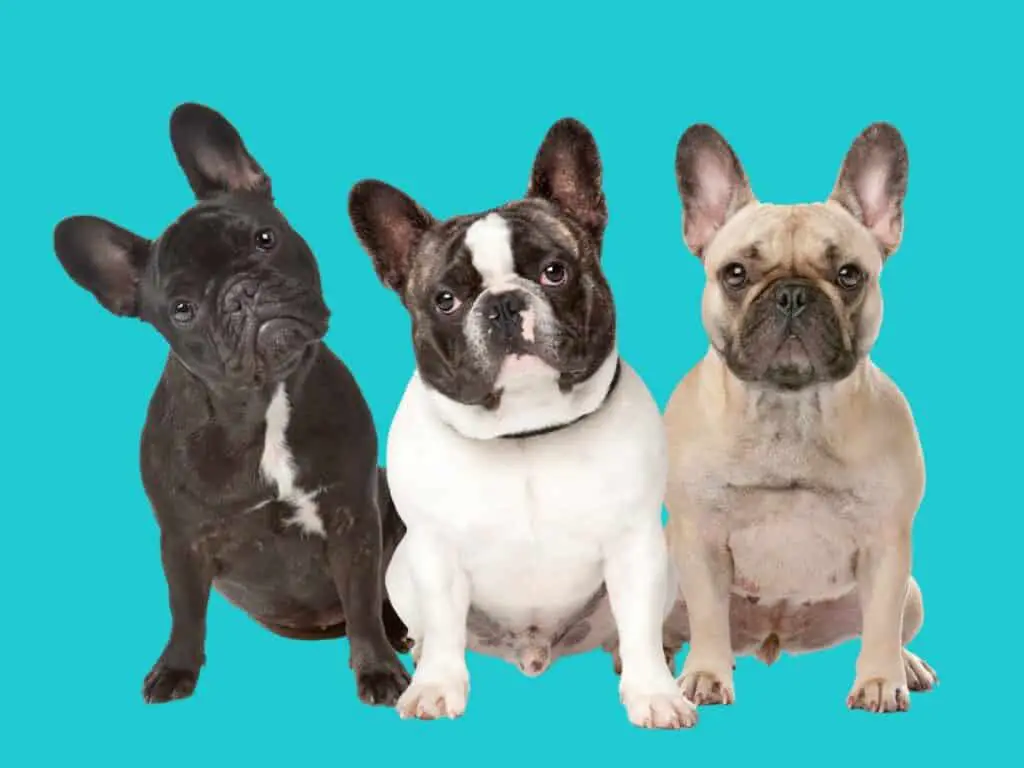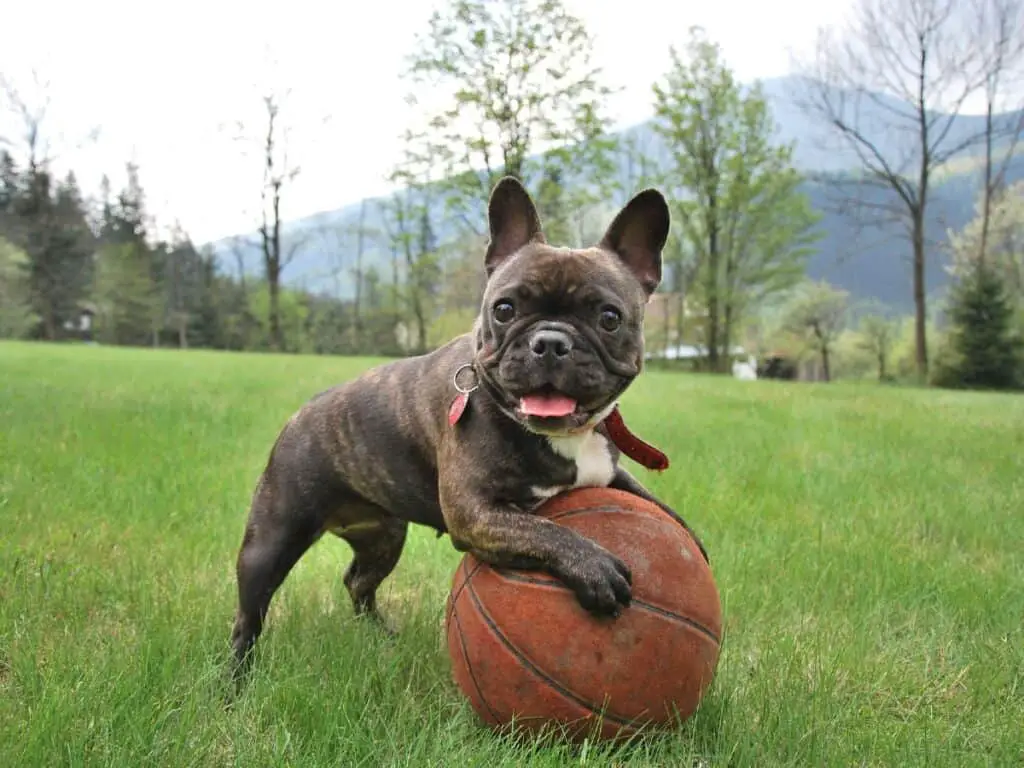If you’ve followed superstars like Lady Gaga, Taylor Swift, and John Legend on social media, you know very well that they like to pose with their adorable French Bulldogs. And it’s no wonder they can’t get enough of this dog breed — Frenchies are gentle, affectionate, loyal, clingy, apartment friendly, and good with children and other pets.
Besides, French Bulldogs have smooshy faces and big grins that instantly steal everyone’s hearts. Even with their constant drools and groans, these dogs are hundred-percent stinking cute!
But one question remains: Are French Bulldogs easy to care for? Take your time reading this easy-to-use reference guide.

Quick Facts: French Bulldog
Height
11 - 13 inchesWeight
16 - 28 poundsLifespan
10-13 yearsBreed Size
small (0-25 lbs.)Breed Type
purebredBreed Group
companion, toyTemperament
gentle, outgoing, playful, protective, clingy, affectionate, loyal, stubbornGood With
families, other dogs, catsIntelligence
averageShedding
infrequentExercise Needs
lowBarking Level
lowEnergy level
lowDrool Amount
highCoat Type
fine, smooth, shortCoat Patterns
bi-color, brindle, flecked, single color, speckled, tickedColors
black, brown/chocolate, cream, fawn, brindle, blue brindle, pied, blue fawnOther Characteristics
apartment-friendly, easy to groom, good for first-time pet owners, hypoallergenic, prone to health issues, strong loyalty tendenciesFrench Bulldog Highlights
- Frenchies originally had rose-like ear shapes. However, American breeders preferred the unique bat-eared look of the French Bulldog. So today, French bulldog owners enjoy the unique bat-eared appearance of their dogs.
- One of French Bulldogs’ most notable and amusing features is that they often fart excessively. But this isn’t just true for French Bulldogs; any dog that has been fed too many fatty foods will likely fart frequently.
- The shape of the Frenchie’s’ head affects their eating habits. Flat faces and small noses make it hard for them to eat properly. Excess air also accumulates in their bellies because they consume their meals too fast.
- French Bulldogs make good watch dogs because they’re always ready to warn their owners when someone approaches them. But they don’t usually start barking unless there’s something wrong.
- They do not tolerate high temperatures very well and must stay cool during warm weather.
- French Bulldogs need lots of attention from their owners. They cannot be kept alone for long and must always be supervised if they are going to be let out into the garden.
History
French Bulldogs don’t come from France at all; instead, they start with ancient Greece.
Ancient Greek tribesmen, called the Molossians, bred huge dogs for work and warfare. These were known as the Molossus breed.
From the Molossus breed came a number of breeds, and from those breeds countless others, including Bullenbeisser, Pitbulls, Rottweilers, Great Pyrenees, and St. Bernards. The Bullenbeiser, now extinct, was once a popular dog breed for hunting bulls. Today, these breeds are known as French Bulldogs, American Bulldogs, English Bulldogs, and Olde English Bulldogge.
When talking about the history of the French Bulldogs, we should also include the influences of England, France, and America. England created the original Bulldogs; these were large dogs bred for strength. Breeders in France changed them into smaller dogs so they would be easier to handle. Finally, American breeders added the bat-shaped ears that gave us the beautiful Frenchie we know today. All of these countries contributed to shaping the French Bulldog.
By 1835, Britain had banned the cruel practice of bull baiting. As a result, breeders started crossbreeding the massive Bullenbeiser to create the modern bulldog breeds.
In 1851, London was filled with mini Bulldogs. These bulldogs barely resembled their Bullenbeisser ancestors, having only the famously short muzzle, flat face, and compact French Bulldog body. They were no longer used for hunting but instead became companion dogs. Before they arrived in France, the Bulldog was crossbred with the pug and terrier breeds.
By 1860, lace makers from Nottingham, who had been displaced by industrialization, moved to France to find employment in Normandy. These women took their dog companions with them, including the mini bulldog breed. The French quickly accepted the mini Bulldog, and soon after, mini bulldog breeding spread throughout Europe.
The ones the English considered too ugly to be bred were sent directly to France. The French liked the qualities of the Bulldog that had been rejected by the English, including its size and standing erect ears. These dogs were soon named the Bouledogue Français.
Thirty-three years later, the Bouledogue Français was brought back to England. Breeders from this country were unhappy with the new arrival because they didn’t meet the English Bulldog’s strict breeding requirements. In addition, they feared that the Bouledogue Français and the English Bulldog would damage the integrity of each breed when crossed.
As a result of the rejection, supporters of the Bouledogue Français formed their own kennel club and began holding shows. They were later on accepted by the English Kennel Club and were given the official name “French Bulldog” in 1912.
By 1885, French Bulldogs had already arrived in America. They quickly became popular among the social elite who travelled through Europe. But after World War 1, their popularity declined significantly since fewer Frenchies had babies naturally. It took some time until veterinarians were performing safe C-section deliveries.
The popularity of the Boston Terriers also contributed to such decline. It was only in the 1980s that Frenchies became popular again, and this popularity continued to rise until the present.
Most French Bulldogs today are bred by speciality dog breeding facilities using advanced methods like artificial insemination and hygienic cesareans to ensure their puppies’ safety and happiness. However, because these advanced methods are more costly than traditional methods, Frenchies became a luxury breed.
Read also: This Is How Much It Costs To Own A French Bulldog
Appearance

Over-sized bat-like ears
The oversized bat-like ears are one of their most distinct features. Many Frenchies were born with rose-shaped ear folds back then, similar to an English bulldog. Their ears, however, do more than hear. They also convey Frenchie’s mood.
If your French Bulldogs’ ear stands straight up, he may be interested. Likewise, his face will show interest. He’ll probably tilt his head forward to indicate that he wants to hear what you’re saying.
Meanwhile, if your French Bulldog is afraid, his ears will be pulled back, and he may show fear by pulling his head down.
Square head
A French Bulldog’s head shape is quite different from an English Bulldog’s; its forehead is half flat and half domed.
The head of a French bulldog is usually short and thick, with an average length of around 30 centimeters. The ideal head circumference is between 13 and 18.5 inches.
Flat face and short muzzle
French Bulldogs are brachycephalic dogs with flat faces and short muzzles. Because of this physical feature, most Frenchies snort, sniffle, sneeze, cough, and snore loudly. Some people find these noises charming; others find them annoying.
Compact frame with heavy bones
They were originally bred to work as bull hunters. Because of their muscular build, they have a tough exterior that helps them in these roles.
Strong neck and wide chest
French Bulldogs have a strong neck and wide chest. This makes them perfect for people who want a strong dog that can protect them.
Short rear legs
Frenchies have been selectively bred so that their rear leg length is shorter than normal. Although this might appear to be cute for some, it could actually cause some serious health issues.
Because of their short rear legs, Frenchies may suffer from hemivertebra, a congenital condition where the dog’s vertebrae are deformed. With this, your pet may have trouble standing up, walking, and moving around. It may not be possible to interact socially. In simple terms, your Frenchie may lose the ability to move his lower body. At worst, he may end up losing control over her movement completely, becoming permanently paralyzed.
Short tail
French bulldogs have tails that look like they’ve been chopped off. You can find your Frenchie puppy developing any of these tails as he becomes an adult:
Screw tail: This tail wags from left to right and then back to the left again. It makes an “S” shape or a screw.
Straight tail: The tip of the tail is called the “knob”, and it’s believed that it’s the most comfortable for French bulldogs as far as comfort and health conditions. The size of the knob varies between pups.
And then there’s what people call a tail pocket. What is it?
It refers to a small pouch at the base of the tail, which holds anything from grass bits to dirt. Not all Frenchies have tail pockets. Some just have small indentions under their tails; others have deeper pockets that can be difficult to clean out.
Generally, tail pockets vary from litter to litter. And whether they have them or not doesn’t affect their personality.
Read also: Are French Bulldogs’ Tails Docked?
French Bulldog Size
Generally, a Frenchie is about 11 to 13 inches tall and weighs 16 to 18 pounds.
French Bulldog Colors
After having your mind fixed on the French Bulldog breed, the fun part comes: deciding which color to get! Below, we’ve compiled a list of all of the most popular French bulldogs. Regardless of your personal preference, there’s a Frenchie for you.
- Pied Frenchie (white base color with patches of black, brown, and gray)
- Brindle Frenchie (a combination of brown shades and dusky tawny colors)
- Cream Frenchie (signature eggshell color)
- Fawn Frenchie (anywhere between red and tan)
- Chocolate Frenchie (can range from a light milk chocolate color to a dark brown chocolate)
- Black Frenchie (solid black solor)
- Blue Brindle Frenchie (gray color base, brindle pattern on top of the blue coat)
- Blue Fawn Frenchie (fawn shade as the base, blue hue on the back and ears)
How much are Blue French Bulldogs? Find the answer here.
Coat
They have a short, smooth, fine coat that makes them very comfortable to be around.
Personality




French Bulldogs are known for their personality, which is why they make great companions.
Protective
Because French Bulldogs are so lovable and loyal, they often act as protective guardians to their families. This is especially true if there are children present. Frenchies see children as great playmates and want to protect them. As a result, they may become defensive if the child plays with others or around strangers.
It is essential to introduce your French Bulldog puppies to new friends when they are young so they don’t grow up overly protective of their owners. If you teach them to trust new friends, this won’t turn into an issue.
Compassionate
Once properly socialized and trained, French Bulldogs are usually friendly towards strangers and other dogs. They love attention and crave constant companionship from anyone who will give them some.
Their friendly and almost comical nature will quickly earn you over. They’re not at all overbearing, and they’re small enough to be easily handled by children. So having one around children will actually improve their mood and attitude.
Needy
French bulldogs don’t like to be left alone too often. If you’re working long shifts and need to leave your dog unattended for extended periods, they may be prone to developing separation anxieties.
Stubborn
It’s important to train your French Bulldogs before bringing them into a family environment where there are children. They can be a little persistent and stubborn when it comes to learning.
French Bulldog Health
A British veterinarian data study revealed that the French Bulldog is significantly more prone to suffering from a range of serious, chronic health conditions than other breeds. Many of the health issues were related to their shortened facial structure and extreme body shapes.
The most common French bulldog health issues include:
Hemivertebrae
Hemivertebrae is usually associated with a French bulldog screw-tailed breed, but not always. They’re also less likely to develop in French bulldogs with straight tails.
These misaligned vertebrae can cause instability and deformation of the spinal column, leading to damage to the spinal cords. If left untreated, the condition can lead to paralysis. Treatment usually involves therapeutic measures such as massages or physiotherapy. Hemivertebrae is a painful condition; therefore, these types of treatment can help alleviate some of the pain.
Moreover, if you know that your Frenchie has an issue with his spinal cord, then you should limit his physical activity so as not to aggravate the problem. You shouldn’t push him to do jumping exercises or anything else rough.
You must also be extra careful when caring for your Frenchie because they’re fragile and easily injured. Likewise, teach others to take good care of them.
Walking your dog regularly helps maintain its health and strength, especially those body parts supporting the back. Make sure to take your dog for short walks every now and then.
Serving foods rich in healthy fats, such as sardines, salmon, and tuna, will definitely benefit your dog’s health. These fatty acid-rich foods will prevent inflammation and degeneration by helping to keep his body free from toxins. You can feed him these foods two or three times per week.
Tail Pocket Infection
This is another potential issue with your French Bulldog’s tail. Even if you take good precautions when cleaning out your dog’s tail pockets, you may still end up dealing with an infection. Common culprits include droppings inside the dog’s tail, pieces of grass, pollen or dust, and even moisture buildup.
If your dog has this infection, he may experience swelling and redness around his tail and pocket. He may also itch and become uncomfortable when walking. It can be excruciating and even deadly. Hence, it’s crucial to get your dog checked out by a veterinarian as soon as possible so they can assess the situation and give him some medication to help relieve his pain.
Brachycephalic Obstructive Airway Syndrome (BOAS)
Brachycephalic Obstructive Airways Syndrome (BOAS) is the most common French bulldog disorder. It occurs when the dog has a short muzzle and a flat face. As a result, the tissue behind the nose gets compressed, causing breathing difficulties.
Additionally, their flat faces mean they’re less able to pant and cool themselves off when they get too hot. As a result, they’re more prone to heat strokes.
If you want to avoid buying a Frenchie with this health problem, check out its parents’ health records and see if they’ve been screened for this issue.
Intervertebral Disc Disease
This occurs when the discs between vertebrae break down and lose their ability to protect the spine. It can be treated by medication, surgery, or a mix of both.
Corneal Ulcers and Conjunctivitis
Because they have flat faces, Frenchie dogs are more likely to get conjunctivitis or pinkeye. This can be caused by dry eye, irritants, and allergens. Additionally, because their large, prominent eyes are so exposed, they are more likely to get scratched and irritated.
If you notice red eyes, swollen eyes, discharge from the eyes, pawing at the eyes, blinking, and squinting in your dog, contact your vet immediately. These could be signs of corneal ulcers and conjunctivitis.
These health problems are just conditions that Frenchies are prone to. They are more likely than most breeds to develop hemivertebrae, tail pocket infection, BOAS, intervertebral disc disease, corneal ulcers, and conjunctivitis. If you want to lower their chances of developing any of these conditions, it’s best to only purchase puppies from a reputable breeder who knows the history and breeding practices of the dogs they sell.
Lifespan
A French Bulldog typically lives between 10 and 13 years, but its exact lifespan depends on genetic makeup, breeding, and lifestyle.
You can’t really change your dog’s genetic makeup and breeding, but you can influence his lifestyle by providing her with a healthy environment.
French Bulldog Care
Don’t know how to care for a Frenchie puppy? Refer to the guide below.
Face Care Instructions
Their flat faces and many wrinkles require some extra care when it comes to grooming time. Make sure to clean off any debris from each crease with a damp towel or alcohol-free baby wipes at least once a month. If your dog spends a lot of outdoor play or has contact with other animals, it’s best to give them a quick wash every other day.
After washing them, don’t forget to dry their face thoroughly. Moisture left in those deep wrinkles may irritate and encourage bacterial growth.
Ear Care Instructions
Bigger than average ear size is one reason French Bulldog dogs are so adorable. However, their large bat-like ears cause them to collect a lot of dust, mud, and debris inside them. As a result, their ear canals get clogged up quickly.
If an owner isn’t careful, this accumulation of dirt can cause many health issues for their dog. Their ears may smell bad because there’s too much dirt inside them, and their ears could be irritated by this. If a Frenchie has a dirty or infected ear, it’s usually fairly obvious. They could be whining from the pain, scratching their heads, or pawing at their ear.
Ear cleaning should be a regular practice for every dog owner. This is a straightforward procedure. First, take a cotton ball soaked in water and thoroughly clean Frenchie’s ears. This should remove all the debris and dirt that may be stuck in them.
After cleaning the French Bulldog’s ears, use a clean, dry tissue to remove any excess moisture from its ears.
If the French Bulldog is getting regular ear cleaning but still appears excessively concerned with scratching, it could have an underlying problem. Take the dog in for a more thorough examination by a vet.
Tail Pocket Care Instructions
Some tips can help ensure that your Frenchie gets the best chance at avoiding tail pocket infection. First, you’ll need to ensure that you check on his tail pocket frequently. During your daily grooming sessions, make sure that you look at his tail pocket closely and, if necessary, touch it to see whether there’s anything wrong with it.
Then, clean the tail pocket with baby wipes or hydrogen peroxide. Frenchies don’t like having people handle their tail pockets. It could be because they’re extremely sensitive or just don’t enjoy touching their pockets. You may need to train them to be comfortable with it over the course of several weeks with patience and rewards.
Heat Sensitivity Care Instructions
If you own a French Bulldog, watch for overheating signs.
French Bulldogs are very sensitive to the temperature, so if they start panting excessively, they immediately get out of the sun and into a cooler environment. Keeping your dog’s body temperature within the safe range requires having access to clean drinking water.
Frenchies can get just as cold as any other breed. They may also suffer from breathing problems if they’re not kept warm enough. So make sure they have plenty of blankets and bedding to stay cozy. And remember to give them lots of love!
Exercise Instructions
While French Bulldogs don’t require a lot of exercises, you should be aware of their susceptibility to overheating and low stamina, so keep an eye on their weight. Help them stay active by taking them for short walks, playing with them every day inside, and giving them lots of chances to go exploring outside.
French Bulldog Diet
As far as we know, there aren’t any specific guidelines for feeding French Bulldogs. Ideally, your French bulldog will eat a diet mainly of raw meats, but if you cannot provide them with these kinds of meals, they may need to eat something else.
When feeding a French Bulldog, choose high-quality dry dog foods best suited to meet their nutritional requirements.
Food Options
You can choose between commercial dry kibbles, canned pet products, raw meats, and homemade recipes.
Dry kibbles contain various ingredients, such as meat, grain, vitamin supplements, and byproducts. They are easy to digest and low in fat.
Canned pet products like meat and fish are made from high-protein ingredients. Therefore, these products are nutritious and economical.
Raw meat diets consist mainly of ground meat, poultry, and organ meats.
Most homemade recipes for dogs are simple to make and require minimal preparation. Before preparing any type of diet for your Frenchie, consult your veterinarian about proper nutritional needs.
Some Technicalities When Feeding Frenchies
Your pup’s calorie requirements vary depending on size, age, activity levels, and metabolism. The quantity of food required to meet these needs depends on the kind and quality of the food they eat.
To figure out how much of a particular type of pet foods you should give your French Bulldogs, look at the labels on the packages or contact the manufacturers for the information you need; you should also talk to your vet about the best foods for your dog.
Note: Some Frenchies may experience digestive issues when fed wheat products. Foods containing high levels of carbohydrates (such as grains) and foods with excessive amounts of proteins can cause skin irritations or rashes. If you’re concerned about your dog’s health, talk to your veterinarian about dietary changes.
Grooming
French Bulldogs are low shedders but require regular grooming. Their coats are short, shiny and smooth, so they don’t need much maintenance. Brushing them regularly removes loose hairs and distributes oil evenly through their coats.
Since a French bulldog’s nails don’t naturally wear down, they will require regular trimming because excessively long fingernails can cause terrible pain while walking and nail infections.
Children And Other Pets

Are French Bulldogs good dogs? Yes, they are! Frenchies were bred to love children and other animals. They’re playful and fun-loving, so they make great family pets.
With regard to dogs and other animals, French Bulldogs tend to do well because they’re generally non-aggressive and don’t bark often. Make sure to introduce them slowly and in a controlled setting.
French Bulldog Rescue Groups
French Bulldogs are often obtained without any clear understanding of the responsibilities involved in having one, and they usually end up in the hands of rescues in desperate need of adoption or foster homes. If you’re interested, a dog shelter would be a good place to start looking for a Frenchie.
There are a variety of reputable French bulldog rescue organizations throughout the United States. Each organization has its own adoption and surrender policies and charges for its Frenchies.
Short Nose and Friends United Rescue
French Bulldog FAQs
Can French Bulldogs wag their tails?
No. Their tails aren’t long enough to wag, so they use their whole scrunchie butts instead.
Do French Bulldogs eat too fast?
These greedy little pups are known for being food motivated and gobbling up anything they can. If your French Bulldog gobbles up too fast or too much, you may encourage obesity, and you can also increase her risk of puppy bloating. Bloating is deadly and kills many Frenchies each and every day! Slow down how quickly she consumes to help control her weight and prevent her from developing bloating.
Are French Bulldogs hypoallergenic dogs?
Unfortunately, French Bulldogs aren’t hypoallergenic. This means they’re not great for people with allergies. It turns out that their skin rolls, skin folds, saliva and short hair can trigger allergic reactions.
Are black Frenchies rare?
Yes. The black coat color is extremely rare among French bulldogs. It should be noted that some French bulldogs may appear to be completely black, but in reality, they’ll have some brindled markings. The rarity of the black Frenchies makes them significantly more expensive than their standard counterpart.
Are French Bulldogs smart?
Yes. French bulldogs are smart and easy to train if you treat them like a game and keep things fun. They’re not meant to compete in obedience and dog shows, but they can be trained to compete in these activities if you want to give it a go.
French Bulldog Fun Facts
- A champion Frenchie named Gamin de Pycombe was one of the passengers on board the Titanic when it sank.
- Most French bulldogs cannot swim because of a short snout, causing them to tilt their body backwards when swimming.
- French bulldogs became popular among wealthy women in America during the Gilded Age. They cost between $300 and $3,000 each and were owned by many prominent people, including the Jp Morgan and Rockefeller family.
- Frenchies are very sensitive. They do not tolerate criticism easily. If you reprimand them, they may act depressed. They respond better to praise and encouragement.
- French Bulldogs don’t normally reproduce themselves. They require artificial insemination and C-section deliveries. More than 80 percent of litters are born like this.
References
Schlensker, E., & Distl, O. (2013). Prevalence, grading and genetics of hemivertebrae in dogs. Eur J Comp Anim Pract, 23, 119-123.
O’Neill, D. G., Packer, R., Francis, P., Church, D. B., Brodbelt, D. C., & Pegram, C. (2021). French Bulldogs differ to other dogs in the UK in propensity for many common disorders: a VetCompass study. Canine Medicine and Genetics, 8(1), 1-14.
Sherman, B. L. (2008). Separation anxiety in dogs. Compendium, 30(1), 27-42.




